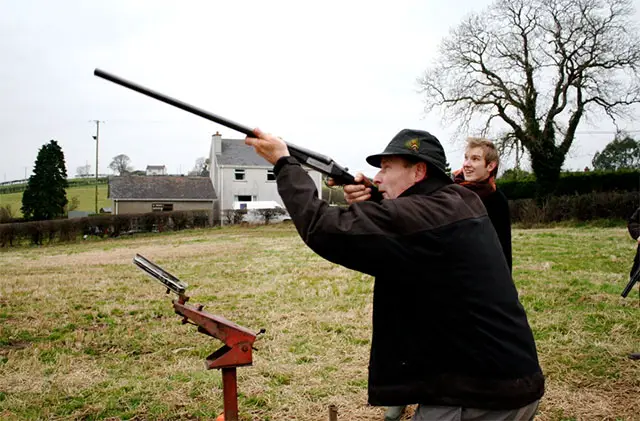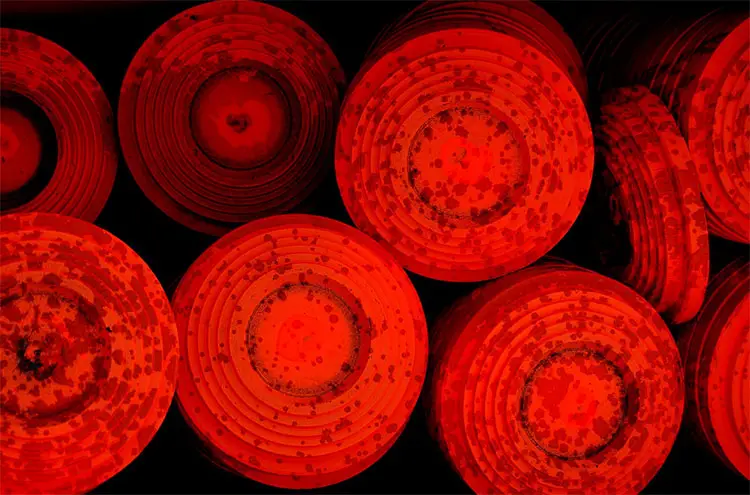Clay pigeon shooting is also known as clay target shooting, and the sport is all about shooting at flying targets, or clay pigeons, with a shotgun.
*This post may contain affiliate links. As an Amazon Associate we earn from qualifying purchases.
With the many different categories of clay pigeon shooting, there are ultimately three different core designations – trap shooting, skeet shooting, and sporting clays.
The Different Types of Shooting

Image from Palelive.com
As you get involved in learning about shooting sports, you’re going to see that there are a few types of shooting you may be interested in. Getting to know the various options will help you understand the ins and outs of shooting and the different clays that are used.
Trap Shooting
Trap shooting gets its name from a time that actual pigeons were used in the sport. Although it was outlawed in the early 1920s, the name stuck. Clays were and still are referred to as birds, and they get released from a trap, also known as a clay thrower.
You can have a single or several traps that are placed fifteen meters in front of the person shooting. The targets are then thrown from the trap in either single or double configurations. Depending on which discipline of trap shooting you’re doing, you may also have a variety of angles, speeds, and heights to contend with.
Some examples of trap shooting are Down the Line or DTL, Double Rise, Olympic Trap, Automatic Ball Trap or ABT, Double Trap, Helice or ZZ, and Universal Trench. Some disciplines are more popular than others and also involve different types of clays that get thrown.
DTL trap shooting is perhaps the most popular and involves five clay targets that are thrown from a fixed height. During the competition, the shooter shoots five times for a total of 25 launches.
Olympic trap is part of the Olympic standards for shooting sports. Fifteen traps are hidden in trenches in front of where the shooter will be standing. These traps are sorted into three groups of five, all set to move in a different potential direction or at different speeds, and all launches are random.
ABT is a watered-down version of Olympic Trap. The way this one works is that there is a single trap doing all of the launchings. The variety in angle, speed, and height is due to the trap’s adjustability to recreate the variation in launches.
Universal trench shooting has a total of five different traps that are used. They are set in a trench in front of the shooter. Each trap is adjusted for varying speeds, angles, and heights. When the shooter calls for release, the clays are launched at random.
Helice shooting is quite possibly one of the most unique disciplines when it comes to trap shooting. The target, also known as the helice, consists of the clay and two plastic propellers attached to the clay. The propellers improve flight unpredictability, therefore, recreating a more realistic shooting experience.
Skeet Shooting
Skeet shooting involves two traps that are opposite of each other with the shooter standing in any of seven different shooting positions. Launchers are approximately forty meters apart. The targets are launched as a single or double release in an arc where one set of clays will cross paths with the opposite set of clays.
Within skeet shooting, you’ll find that there are three subcategories which are English Skeet, American Skeet, and Olympic Skeet. Each one involves the launch of 25 clays and shooting from each of the shooting positions on the line.
English skeet allows for pre-mounted or gun-down position for the shotgun while Olympic skeet mandates the gun-down position until the target is released. Another difference between Olympic skeet and others is that there is an eighth shooting position to shoot from.
Sporting Clays
Sporting clays have the most extensive variety of targets compared to the other types of clay shooting. You’ll find launches from every angle, all at varying speeds, heights, and trajectories. The vast array of differences allows for a more realistic shooting experience and a higher level of difficulty.
The Different Targets
Depending on the discipline of your choice, there is a set standard for the targets used in shooting sports. These international standards result in clay pigeons that are made to fit both size and weight.
As to what they look like, clays look somewhat like shallow bowls that are either bright orange, black, or white. The white clays are unique to helice shooting, while the majority of the rest use either orange or black. They are light and are made of limestone and pitch.
If you were to purchase a box of clays, you’d see a warning about their fragility because they can break easily if you are too rough with them. Remember, they’re designed to be able to be launched from a thrower and then shattered by pellets from a shotgun.
The most common size of clays is 108mm for American versions of skeet, trap, and sporting clays. There is a slightly larger target for international disciplines, and they measure 110 mm in diameter. Of the different types of shooting sports, skeet and trap are the ones that use only the standardized targets. These are also recognized as traditional clay targets.
Sporting clays shooting is different in that it can and will use a variety of targets to increase the likeness of actually shooting live targets launched from different throwers. The clays used include the midi, the mini, the battue, and the rabbit.
The midi is a smaller version of the traditional clay and measures 90 mm in diameter. The mini is even smaller with a 60 mm diameter. Minis tend to look like they move faster due to their size, too. Battue clays are 110 mm in diameter but are flat instead of domed, and they fly quickly. Rabbit clays are also 110 mm in diameter, but these are stronger than traditional clays. Rabbits are designed to run closer to the ground while maintaining their speed.
Clay Simulations

Image from ShootClay.co.uk
There are several different types of clay pigeon simulations when you start getting into the various shooting sports. Their purpose is to simulate the shooting of live game without actually shooting at the real thing.
It has been mentioned that Rabbit clays are shot and go along ground level. These clays also bounce erratically just like an actual rabbit. Hence this type of sporting clays is known as Rabbit.
Another type of sporting clays shooting is Teal shooting. In this layout, a Teal clay is meant to act like a Teal duck. It will fly straight up quickly and falls back down along a similar trajectory. These clays are fast and are difficult to shoot.
Quartering clays go towards you or away from you from varying angles. You have to recognize from where they were launched to figure out where you’re supposed to aim. This type of sporting clays is challenging because predicting the trajectory is difficult due to the different perspectives from where the shooter takes the shot.
Loopers are another brand of sporting clays. These are launched from a greater distance and go towards you or away from you. You can use different techniques to know when to shoot, but the distances are what makes this one challenging.
Sporting clays that are launched in a game of going away are small and fast. They go away from you, so you need to be ready to shoot at a moment’s notice by spotting and following their path, and then shooting at the right time.
Driven clays are meant to simulate birds going in your general direction. These sporting clays can be especially tricky because they go towards you and can sometimes seem to disappear as you’re shooting just because your muzzle covers them up.
Incoming clays are the last of the sporting clays targets. These clays can come at you from any direction with the purpose of looking like a flock of birds heading towards you. Don’t forget to concentrate as you take aim and shoot because they are deceptively tricky to shoot.
[amazon box= “B001SH1LTI,B015GSOEFW,B000JDAB0M,” template=”table”]
Getting it Right
Being able to shoot well at any of these shooting sports is challenging, so don’t expect to hit every target right off the bat. Instead, focus on getting the right equipment to give you the best chance at learning how to shoot correctly.
Shooting accurately at stationary targets will improve your odds of doing well with the different shooting sports that use moving clay pigeons. If you’re new to the sport, start at the beginning and work your way through.
If you’ve been around the block a few times, consider the gun you’re using and maybe swapping for an upgrade or something different altogether. You may find that a different type of shotgun feels better to you than the one you’re currently using.
It takes a few things to be able to get it right, but once you do, you’ll feel the pull that shooting sports has and enjoy the thrill of hitting that clay every time it happens.